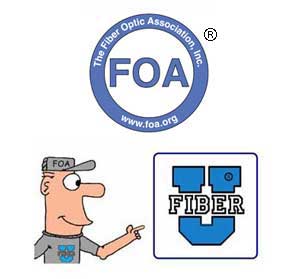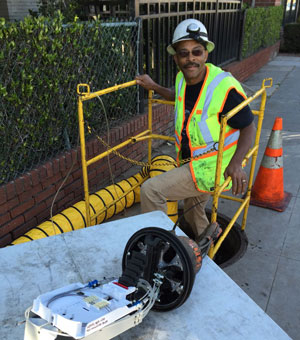Fiber
Optic Cable Midspan Access MiniCourse
Fiber
U MiniCourses are courses on a specific topic that you can
take in about an hour or less. They are based on questions
people ask FOA all the time, so the topics are recommended
by our readers.
Level: Intermediate
Intended For:
Designers
of fiber optic communications networks
Users
of fiber optic communications networks
Contractors and techs who install, operate and maintain
them.
Objectives:
From this self-study program you should learn:
What
midspan access is and how it is used at splice points
and with drop cables
How
midspan access can be used in fiber optic installation
of drop cables to save cost and time
How
fiber optic midspan access is done
- Prerequisites

When
you finish, you can take an online test on this course to
qualify for a "Fiber U Certificate of Completion." The
test cost for a Fiber U MiniCourse is $10US.
Introduction
Many
installations involve splitting the fibers in a backbone
cable or dropping a small fiber count cable from a large
backbone cable. Backbone cables of 144-288 fibers are
common and larger ones are becoming more common too.
Drop cables are often only 2-14 fibers, meaning most
fibers are continuing straight through the drop point.
Midspan access involves opening the cable by removing
the jacket and strength members, opening the buffer tube
and splicing only the fibers being dropped at that
point. The untouched buffer tubes from the opened cable
are carefully rolled up and stored in the same splice
closure as the fibers that will be separated and spliced
to a drop cable.
This Fiber U MiniCourse will explain how a high fiber
count backbone or distribution cable can drop just a few
fibers at a location without splicing all the fibers in
the cable, saving time and cost. .
Assignments
For
this lesson plan you will be instructed to watch the
videos, read
the references
and take a quiz (Test Your Knowledge) to complete the
course.
Lesson
Plans
Watch
the videos, read the section in the FOA Guide and take
the quiz. For this course, we recommend watching the
videos first and then reading the FOA Guide page on
Restoration. There is a short quiz you can use to check
your comprehension. The Certificate of Completion test
is based on those materials.
Videos
FOA
Lecture 59 - Fiber Optic Cable Midspan Access
FOA Guide
Fiber
Optic Cable Installation - Midspan Access
Test Your Comprehension
Quiz - Fiber
Optic Cable Midspan Access

When
you finish all the assignments you can take an online test
on this course to qualify for a "Fiber U Certificate of
Completion." The test cost is $10US.
Go here to take the "Fiber
Optic Cable Midspan Access" Certificate
of Completion test.. Here
are detail directions if this is your first time
taking a Fiber
U Certificate of Completion exam.
This information is
provided by The Fiber Optic Association, Inc. as a
benefit to those interested in teaching, designing,
manufacturing, selling, installing or using fiber optic
communications systems or networks. It is intended to be
used as an overview and/or basic guidelines and in no
way should be considered to be complete or
comprehensive. These guidelines are strictly the opinion
of the FOA and the reader is expected to use them as a
basis for learning, as a reference and for creating
their own documentation, project specifications, etc.
Those working with fiber optics in the classroom,
laboratory or field should follow all safety rules
carefully. The FOA assumes no liability for the use of
any of this material.
|



